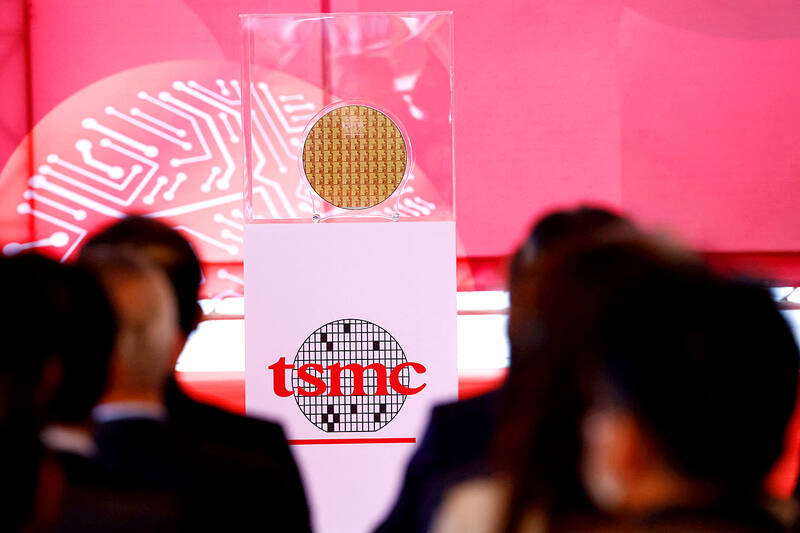Taiwan’s foundry industry would see its global market share dip to 44 percent in 2026 as the US, China and other countries race to build local capacity to boost chip resilience amid escalating geopolitical risks, TrendForce Corp (集邦科技) said yesterday.
At present, Taiwan’s major foundry services providers together command 47 percent of the global market, statistics provided by TrendForce showed.
“Governments around the world are offering subsidies or tax incentives to encourage construction of local chip capacity, with the aim of minimizing risks of being overly dependent on Taiwan or Asia for chip supply amid rising geopolitical risks,” TrendForce analyst Joanne Chiao (喬安) told a forum organized by the research house in Taipei.

Photo: Ann Wang, Reuters
“The US and Japan are concentrating mostly on expanding advanced semiconductor capacity at home,” she said.
As a result, Taiwan’s foundry industry would see a bigger market share decline of 14 percentage points to 66 percent in 2026 from 80 percent now in the advanced chips area, that is, 7-nanometer, 5-nanometer or 3-nanometer chips, the researcher said.
“Despite the market share loss, Taiwan will continue to play a critical part in the world’s semiconductor supply chain as the world’s most advanced chips will still be made in Taiwan,” Chiao said.
Taiwan Semiconductor Manufacturing Co (台積電) expects to ramp up production of 2-nanometer chips in 2025 at its factories in Hsinchu and Taichung.
The chipmaker’s Arizona plant is to start making 4-nanometer chips by the end of next year.
The US would see its market share jump to 12 percent in 2026, from a very minimal share, in the advanced chips segment, the statistics showed.
China would see little progress, accounting for only 1 percent of the global market, as major Chinese chipmakers Semiconductor Manufacturing International Corp (中芯國際) and Hua Hong Semiconductor Ltd (華虹半導體) are unable to access key equipment for technology upgrades due to export restrictions from the US and Japan, TrendForce said.
The US and Japan have banned companies from exporting advanced semiconductor equipment and technology used in making 16-nanometer and more advanced chips to China.
The Netherlands might soon follow suit, Chiao said.
“Photolithography equipment is the choke point for China in expanding to advanced semiconductor technologies,” Chiao said. “The export restrictions will hold back China’s progress significantly.”
ASML Holding NV of the Netherlands is the world’s only supplier of photolithography equipment, or extreme ultraviolet lithography tools used in 3-nanometer technology, TrendForce said.
Japan’s Nikon Precision Industry Inc and Canon Inc supply photolithography equipment used in 28-nanometer technology.
Shanghai Micro Electronics Equipment Group (上海微電子), China’s sole semiconductor lithography specialist, can only supply equipment used in less advanced 90-nanometer technology at best, TrendForce said.
Overall, China’s market share is expected to rise to as high as 26 percent in 2026 from 24 percent this year, as it provides significant subsidies for domestic semiconductor capacity expansions in a bid to achieve its ambitious goal of achieving 70 percent chip self-sufficiency by 2025, it said.

The US dollar was trading at NT$29.7 at 10am today on the Taipei Foreign Exchange, as the New Taiwan dollar gained NT$1.364 from the previous close last week. The NT dollar continued to rise today, after surging 3.07 percent on Friday. After opening at NT$30.91, the NT dollar gained more than NT$1 in just 15 minutes, briefly passing the NT$30 mark. Before the US Department of the Treasury's semi-annual currency report came out, expectations that the NT dollar would keep rising were already building. The NT dollar on Friday closed at NT$31.064, up by NT$0.953 — a 3.07 percent single-day gain. Today,

‘SHORT TERM’: The local currency would likely remain strong in the near term, driven by anticipated US trade pressure, capital inflows and expectations of a US Fed rate cut The US dollar is expected to fall below NT$30 in the near term, as traders anticipate increased pressure from Washington for Taiwan to allow the New Taiwan dollar to appreciate, Cathay United Bank (國泰世華銀行) chief economist Lin Chi-chao (林啟超) said. Following a sharp drop in the greenback against the NT dollar on Friday, Lin told the Central News Agency that the local currency is likely to remain strong in the short term, driven in part by market psychology surrounding anticipated US policy pressure. On Friday, the US dollar fell NT$0.953, or 3.07 percent, closing at NT$31.064 — its lowest level since Jan.

The New Taiwan dollar and Taiwanese stocks surged on signs that trade tensions between the world’s top two economies might start easing and as US tech earnings boosted the outlook of the nation’s semiconductor exports. The NT dollar strengthened as much as 3.8 percent versus the US dollar to 30.815, the biggest intraday gain since January 2011, closing at NT$31.064. The benchmark TAIEX jumped 2.73 percent to outperform the region’s equity gauges. Outlook for global trade improved after China said it is assessing possible trade talks with the US, providing a boost for the nation’s currency and shares. As the NT dollar

The Financial Supervisory Commission (FSC) yesterday met with some of the nation’s largest insurance companies as a skyrocketing New Taiwan dollar piles pressure on their hundreds of billions of dollars in US bond investments. The commission has asked some life insurance firms, among the biggest Asian holders of US debt, to discuss how the rapidly strengthening NT dollar has impacted their operations, people familiar with the matter said. The meeting took place as the NT dollar jumped as much as 5 percent yesterday, its biggest intraday gain in more than three decades. The local currency surged as exporters rushed to